Financial Accounting: IFRS 16 and its impact on Financial Reporting
VerifiedAdded on 2021/04/07
|7
|2366
|106
Essay
AI Summary
This essay analyzes the implications of IFRS 16, the new International Financial Reporting Standard on leases, which mandates that all leases be treated as finance leases. It examines the reasons behind the issuance of IFRS 16, highlighting the inconsistencies in previous standards like IAS 17 and the need for a more transparent representation of financial leverage. The essay details the significant impact of IFRS 16 on financial statements, including changes in assets, liabilities, equity, and key financial ratios such as leverage and profitability ratios. It focuses on the retail sector, which is particularly affected due to its high volume of operating leases, leading to substantial adjustments in debt and EBITDA. The essay concludes by emphasizing the increased transparency and clarity in financial reporting provided by IFRS 16, while also acknowledging the need for further research, especially in regions beyond Europe and America, and the importance of addressing financial statement balance post-adoption.
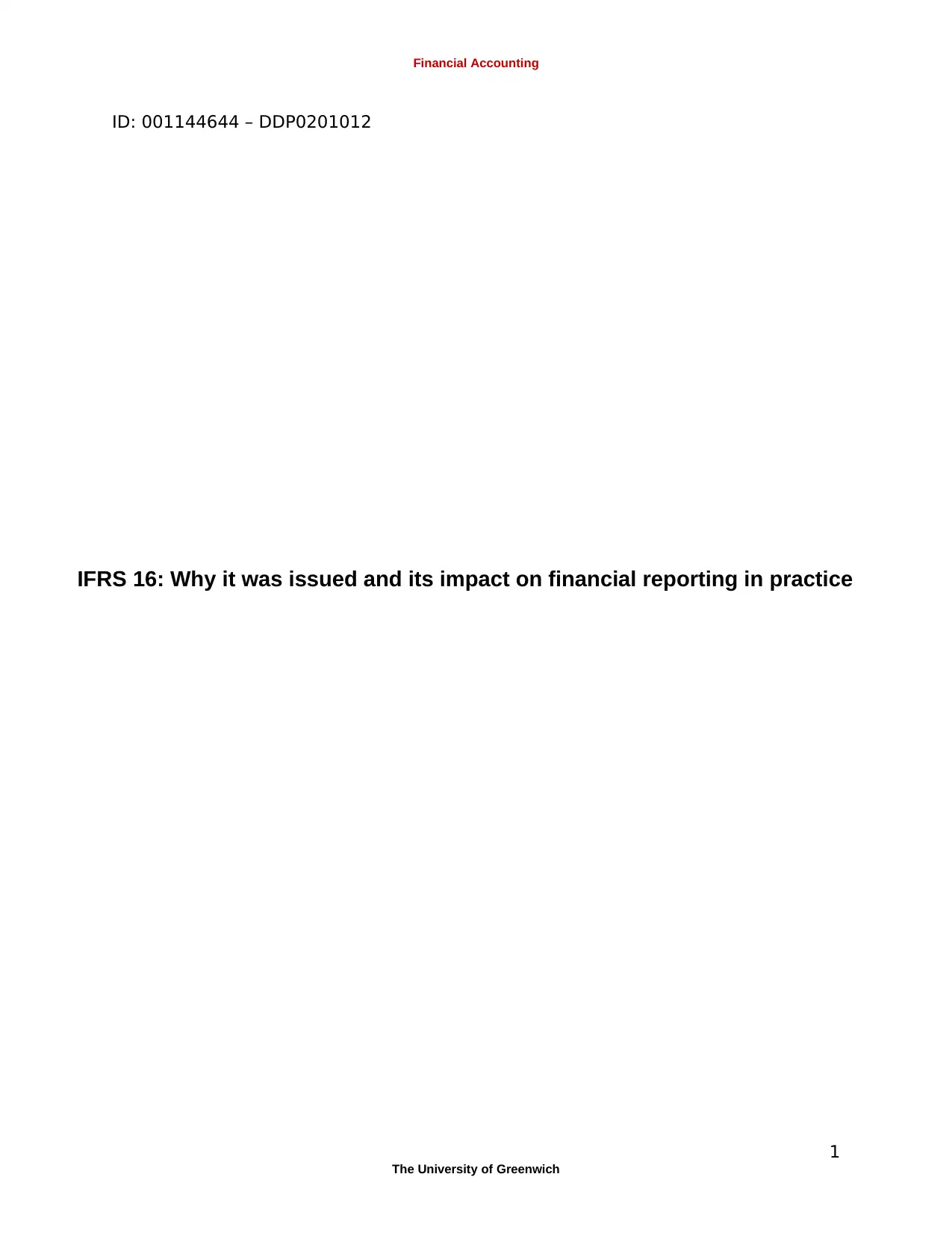
Financial Accounting
ID: 001144644 – DDP0201012
IFRS 16: Why it was issued and its impact on financial reporting in practice
1
The University of Greenwich
ID: 001144644 – DDP0201012
IFRS 16: Why it was issued and its impact on financial reporting in practice
1
The University of Greenwich
Paraphrase This Document
Need a fresh take? Get an instant paraphrase of this document with our AI Paraphraser
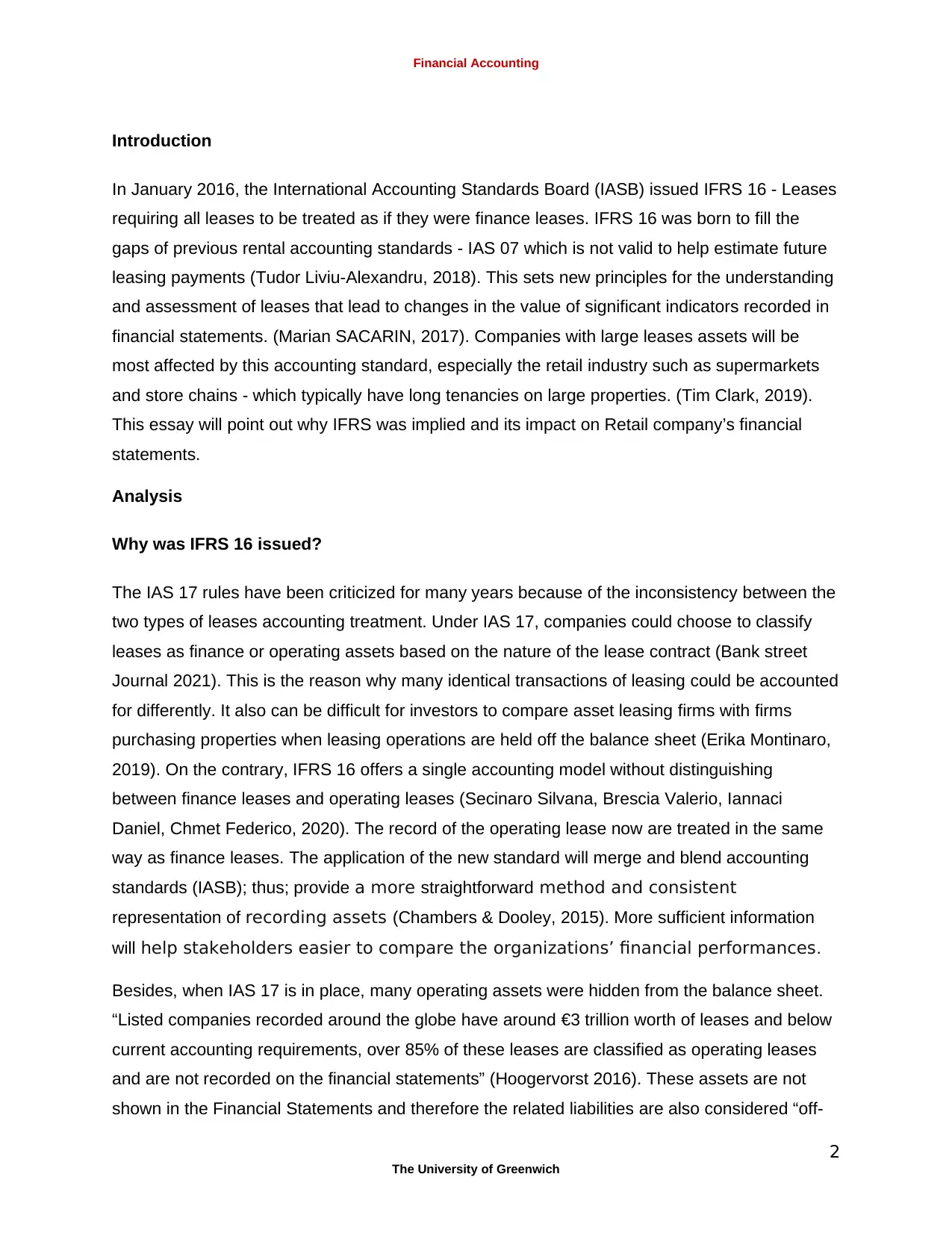
Financial Accounting
Introduction
In January 2016, the International Accounting Standards Board (IASB) issued IFRS 16 - Leases
requiring all leases to be treated as if they were finance leases. IFRS 16 was born to fill the
gaps of previous rental accounting standards - IAS 07 which is not valid to help estimate future
leasing payments (Tudor Liviu-Alexandru, 2018). This sets new principles for the understanding
and assessment of leases that lead to changes in the value of significant indicators recorded in
financial statements. (Marian SACARIN, 2017). Companies with large leases assets will be
most affected by this accounting standard, especially the retail industry such as supermarkets
and store chains - which typically have long tenancies on large properties. (Tim Clark, 2019).
This essay will point out why IFRS was implied and its impact on Retail company’s financial
statements.
Analysis
Why was IFRS 16 issued?
The IAS 17 rules have been criticized for many years because of the inconsistency between the
two types of leases accounting treatment. Under IAS 17, companies could choose to classify
leases as finance or operating assets based on the nature of the lease contract (Bank street
Journal 2021). This is the reason why many identical transactions of leasing could be accounted
for differently. It also can be difficult for investors to compare asset leasing firms with firms
purchasing properties when leasing operations are held off the balance sheet (Erika Montinaro,
2019). On the contrary, IFRS 16 offers a single accounting model without distinguishing
between finance leases and operating leases (Secinaro Silvana, Brescia Valerio, Iannaci
Daniel, Chmet Federico, 2020). The record of the operating lease now are treated in the same
way as finance leases. The application of the new standard will merge and blend accounting
standards (IASB); thus; provide a more straightforward method and consistent
representation of recording assets (Chambers & Dooley, 2015). More sufficient information
will help stakeholders easier to compare the organizations’ financial performances.
Besides, when IAS 17 is in place, many operating assets were hidden from the balance sheet.
“Listed companies recorded around the globe have around €3 trillion worth of leases and below
current accounting requirements, over 85% of these leases are classified as operating leases
and are not recorded on the financial statements” (Hoogervorst 2016). These assets are not
shown in the Financial Statements and therefore the related liabilities are also considered “off-
2
The University of Greenwich
Introduction
In January 2016, the International Accounting Standards Board (IASB) issued IFRS 16 - Leases
requiring all leases to be treated as if they were finance leases. IFRS 16 was born to fill the
gaps of previous rental accounting standards - IAS 07 which is not valid to help estimate future
leasing payments (Tudor Liviu-Alexandru, 2018). This sets new principles for the understanding
and assessment of leases that lead to changes in the value of significant indicators recorded in
financial statements. (Marian SACARIN, 2017). Companies with large leases assets will be
most affected by this accounting standard, especially the retail industry such as supermarkets
and store chains - which typically have long tenancies on large properties. (Tim Clark, 2019).
This essay will point out why IFRS was implied and its impact on Retail company’s financial
statements.
Analysis
Why was IFRS 16 issued?
The IAS 17 rules have been criticized for many years because of the inconsistency between the
two types of leases accounting treatment. Under IAS 17, companies could choose to classify
leases as finance or operating assets based on the nature of the lease contract (Bank street
Journal 2021). This is the reason why many identical transactions of leasing could be accounted
for differently. It also can be difficult for investors to compare asset leasing firms with firms
purchasing properties when leasing operations are held off the balance sheet (Erika Montinaro,
2019). On the contrary, IFRS 16 offers a single accounting model without distinguishing
between finance leases and operating leases (Secinaro Silvana, Brescia Valerio, Iannaci
Daniel, Chmet Federico, 2020). The record of the operating lease now are treated in the same
way as finance leases. The application of the new standard will merge and blend accounting
standards (IASB); thus; provide a more straightforward method and consistent
representation of recording assets (Chambers & Dooley, 2015). More sufficient information
will help stakeholders easier to compare the organizations’ financial performances.
Besides, when IAS 17 is in place, many operating assets were hidden from the balance sheet.
“Listed companies recorded around the globe have around €3 trillion worth of leases and below
current accounting requirements, over 85% of these leases are classified as operating leases
and are not recorded on the financial statements” (Hoogervorst 2016). These assets are not
shown in the Financial Statements and therefore the related liabilities are also considered “off-
2
The University of Greenwich
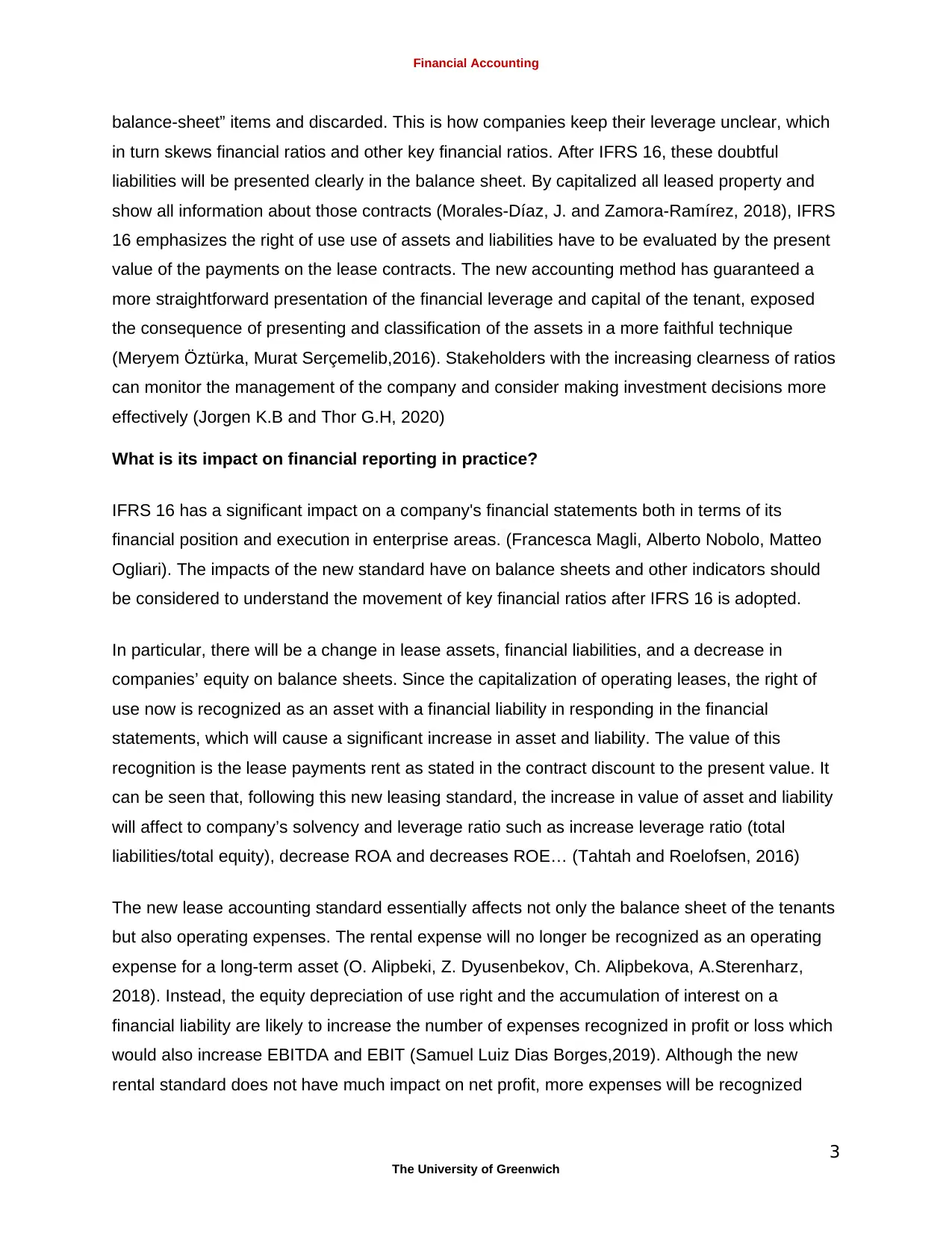
Financial Accounting
balance-sheet” items and discarded. This is how companies keep their leverage unclear, which
in turn skews financial ratios and other key financial ratios. After IFRS 16, these doubtful
liabilities will be presented clearly in the balance sheet. By capitalized all leased property and
show all information about those contracts (Morales-Díaz, J. and Zamora-Ramírez, 2018), IFRS
16 emphasizes the right of use use of assets and liabilities have to be evaluated by the present
value of the payments on the lease contracts. The new accounting method has guaranteed a
more straightforward presentation of the financial leverage and capital of the tenant, exposed
the consequence of presenting and classification of the assets in a more faithful technique
(Meryem Öztürka, Murat Serçemelib,2016). Stakeholders with the increasing clearness of ratios
can monitor the management of the company and consider making investment decisions more
effectively (Jorgen K.B and Thor G.H, 2020)
What is its impact on financial reporting in practice?
IFRS 16 has a significant impact on a company's financial statements both in terms of its
financial position and execution in enterprise areas. (Francesca Magli, Alberto Nobolo, Matteo
Ogliari). The impacts of the new standard have on balance sheets and other indicators should
be considered to understand the movement of key financial ratios after IFRS 16 is adopted.
In particular, there will be a change in lease assets, financial liabilities, and a decrease in
companies’ equity on balance sheets. Since the capitalization of operating leases, the right of
use now is recognized as an asset with a financial liability in responding in the financial
statements, which will cause a significant increase in asset and liability. The value of this
recognition is the lease payments rent as stated in the contract discount to the present value. It
can be seen that, following this new leasing standard, the increase in value of asset and liability
will affect to company’s solvency and leverage ratio such as increase leverage ratio (total
liabilities/total equity), decrease ROA and decreases ROE… (Tahtah and Roelofsen, 2016)
The new lease accounting standard essentially affects not only the balance sheet of the tenants
but also operating expenses. The rental expense will no longer be recognized as an operating
expense for a long-term asset (O. Alipbeki, Z. Dyusenbekov, Ch. Alipbekova, A.Sterenharz,
2018). Instead, the equity depreciation of use right and the accumulation of interest on a
financial liability are likely to increase the number of expenses recognized in profit or loss which
would also increase EBITDA and EBIT (Samuel Luiz Dias Borges,2019). Although the new
rental standard does not have much impact on net profit, more expenses will be recognized
3
The University of Greenwich
balance-sheet” items and discarded. This is how companies keep their leverage unclear, which
in turn skews financial ratios and other key financial ratios. After IFRS 16, these doubtful
liabilities will be presented clearly in the balance sheet. By capitalized all leased property and
show all information about those contracts (Morales-Díaz, J. and Zamora-Ramírez, 2018), IFRS
16 emphasizes the right of use use of assets and liabilities have to be evaluated by the present
value of the payments on the lease contracts. The new accounting method has guaranteed a
more straightforward presentation of the financial leverage and capital of the tenant, exposed
the consequence of presenting and classification of the assets in a more faithful technique
(Meryem Öztürka, Murat Serçemelib,2016). Stakeholders with the increasing clearness of ratios
can monitor the management of the company and consider making investment decisions more
effectively (Jorgen K.B and Thor G.H, 2020)
What is its impact on financial reporting in practice?
IFRS 16 has a significant impact on a company's financial statements both in terms of its
financial position and execution in enterprise areas. (Francesca Magli, Alberto Nobolo, Matteo
Ogliari). The impacts of the new standard have on balance sheets and other indicators should
be considered to understand the movement of key financial ratios after IFRS 16 is adopted.
In particular, there will be a change in lease assets, financial liabilities, and a decrease in
companies’ equity on balance sheets. Since the capitalization of operating leases, the right of
use now is recognized as an asset with a financial liability in responding in the financial
statements, which will cause a significant increase in asset and liability. The value of this
recognition is the lease payments rent as stated in the contract discount to the present value. It
can be seen that, following this new leasing standard, the increase in value of asset and liability
will affect to company’s solvency and leverage ratio such as increase leverage ratio (total
liabilities/total equity), decrease ROA and decreases ROE… (Tahtah and Roelofsen, 2016)
The new lease accounting standard essentially affects not only the balance sheet of the tenants
but also operating expenses. The rental expense will no longer be recognized as an operating
expense for a long-term asset (O. Alipbeki, Z. Dyusenbekov, Ch. Alipbekova, A.Sterenharz,
2018). Instead, the equity depreciation of use right and the accumulation of interest on a
financial liability are likely to increase the number of expenses recognized in profit or loss which
would also increase EBITDA and EBIT (Samuel Luiz Dias Borges,2019). Although the new
rental standard does not have much impact on net profit, more expenses will be recognized
3
The University of Greenwich
⊘ This is a preview!⊘
Do you want full access?
Subscribe today to unlock all pages.

Trusted by 1+ million students worldwide
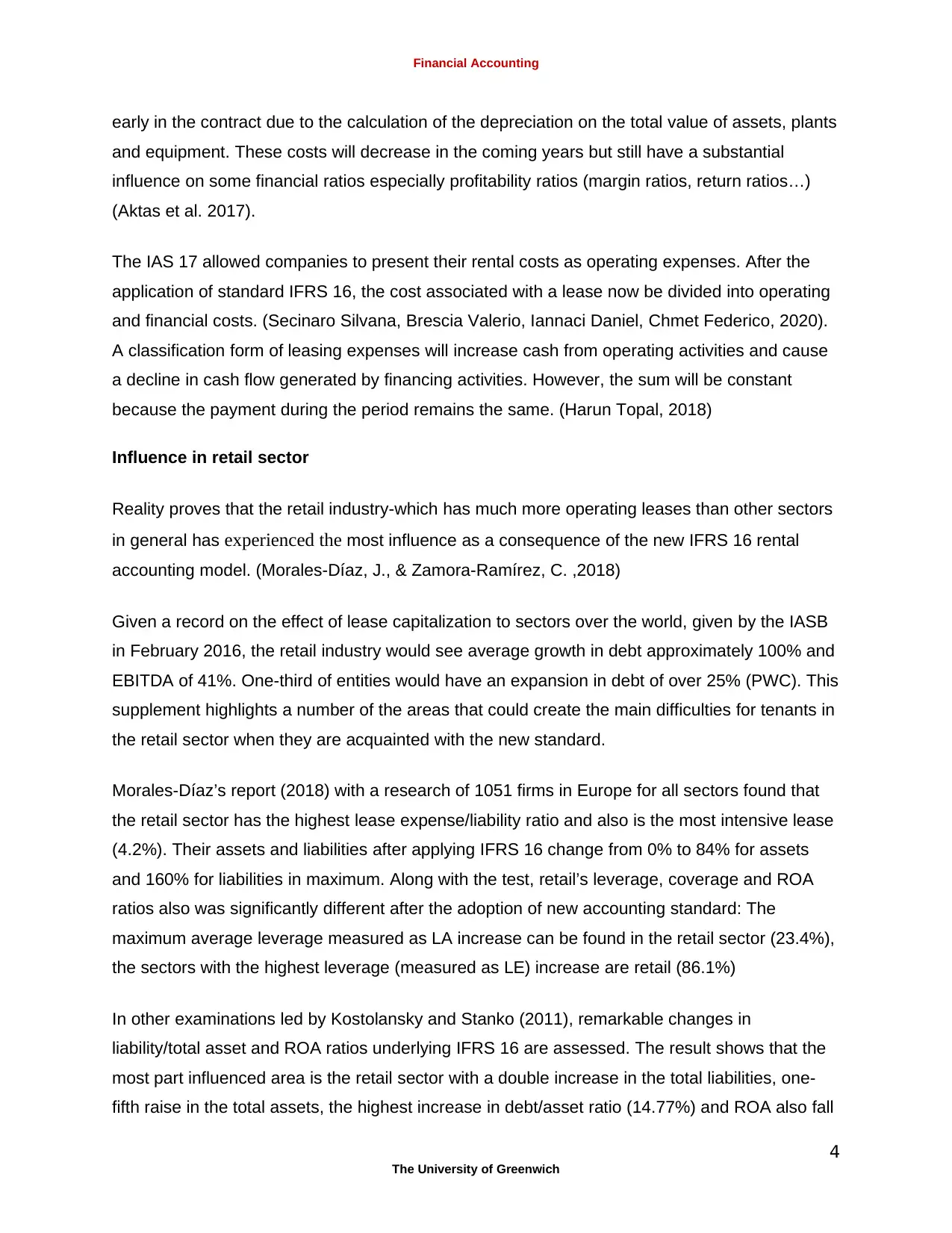
Financial Accounting
early in the contract due to the calculation of the depreciation on the total value of assets, plants
and equipment. These costs will decrease in the coming years but still have a substantial
influence on some financial ratios especially profitability ratios (margin ratios, return ratios…)
(Aktas et al. 2017).
The IAS 17 allowed companies to present their rental costs as operating expenses. After the
application of standard IFRS 16, the cost associated with a lease now be divided into operating
and financial costs. (Secinaro Silvana, Brescia Valerio, Iannaci Daniel, Chmet Federico, 2020).
A classification form of leasing expenses will increase cash from operating activities and cause
a decline in cash flow generated by financing activities. However, the sum will be constant
because the payment during the period remains the same. (Harun Topal, 2018)
Influence in retail sector
Reality proves that the retail industry-which has much more operating leases than other sectors
in general has experienced the most influence as a consequence of the new IFRS 16 rental
accounting model. (Morales-Díaz, J., & Zamora-Ramírez, C. ,2018)
Given a record on the effect of lease capitalization to sectors over the world, given by the IASB
in February 2016, the retail industry would see average growth in debt approximately 100% and
EBITDA of 41%. One-third of entities would have an expansion in debt of over 25% (PWC). This
supplement highlights a number of the areas that could create the main difficulties for tenants in
the retail sector when they are acquainted with the new standard.
Morales-Díaz’s report (2018) with a research of 1051 firms in Europe for all sectors found that
the retail sector has the highest lease expense/liability ratio and also is the most intensive lease
(4.2%). Their assets and liabilities after applying IFRS 16 change from 0% to 84% for assets
and 160% for liabilities in maximum. Along with the test, retail’s leverage, coverage and ROA
ratios also was significantly different after the adoption of new accounting standard: The
maximum average leverage measured as LA increase can be found in the retail sector (23.4%),
the sectors with the highest leverage (measured as LE) increase are retail (86.1%)
In other examinations led by Kostolansky and Stanko (2011), remarkable changes in
liability/total asset and ROA ratios underlying IFRS 16 are assessed. The result shows that the
most part influenced area is the retail sector with a double increase in the total liabilities, one-
fifth raise in the total assets, the highest increase in debt/asset ratio (14.77%) and ROA also fall
4
The University of Greenwich
early in the contract due to the calculation of the depreciation on the total value of assets, plants
and equipment. These costs will decrease in the coming years but still have a substantial
influence on some financial ratios especially profitability ratios (margin ratios, return ratios…)
(Aktas et al. 2017).
The IAS 17 allowed companies to present their rental costs as operating expenses. After the
application of standard IFRS 16, the cost associated with a lease now be divided into operating
and financial costs. (Secinaro Silvana, Brescia Valerio, Iannaci Daniel, Chmet Federico, 2020).
A classification form of leasing expenses will increase cash from operating activities and cause
a decline in cash flow generated by financing activities. However, the sum will be constant
because the payment during the period remains the same. (Harun Topal, 2018)
Influence in retail sector
Reality proves that the retail industry-which has much more operating leases than other sectors
in general has experienced the most influence as a consequence of the new IFRS 16 rental
accounting model. (Morales-Díaz, J., & Zamora-Ramírez, C. ,2018)
Given a record on the effect of lease capitalization to sectors over the world, given by the IASB
in February 2016, the retail industry would see average growth in debt approximately 100% and
EBITDA of 41%. One-third of entities would have an expansion in debt of over 25% (PWC). This
supplement highlights a number of the areas that could create the main difficulties for tenants in
the retail sector when they are acquainted with the new standard.
Morales-Díaz’s report (2018) with a research of 1051 firms in Europe for all sectors found that
the retail sector has the highest lease expense/liability ratio and also is the most intensive lease
(4.2%). Their assets and liabilities after applying IFRS 16 change from 0% to 84% for assets
and 160% for liabilities in maximum. Along with the test, retail’s leverage, coverage and ROA
ratios also was significantly different after the adoption of new accounting standard: The
maximum average leverage measured as LA increase can be found in the retail sector (23.4%),
the sectors with the highest leverage (measured as LE) increase are retail (86.1%)
In other examinations led by Kostolansky and Stanko (2011), remarkable changes in
liability/total asset and ROA ratios underlying IFRS 16 are assessed. The result shows that the
most part influenced area is the retail sector with a double increase in the total liabilities, one-
fifth raise in the total assets, the highest increase in debt/asset ratio (14.77%) and ROA also fall
4
The University of Greenwich
Paraphrase This Document
Need a fresh take? Get an instant paraphrase of this document with our AI Paraphraser
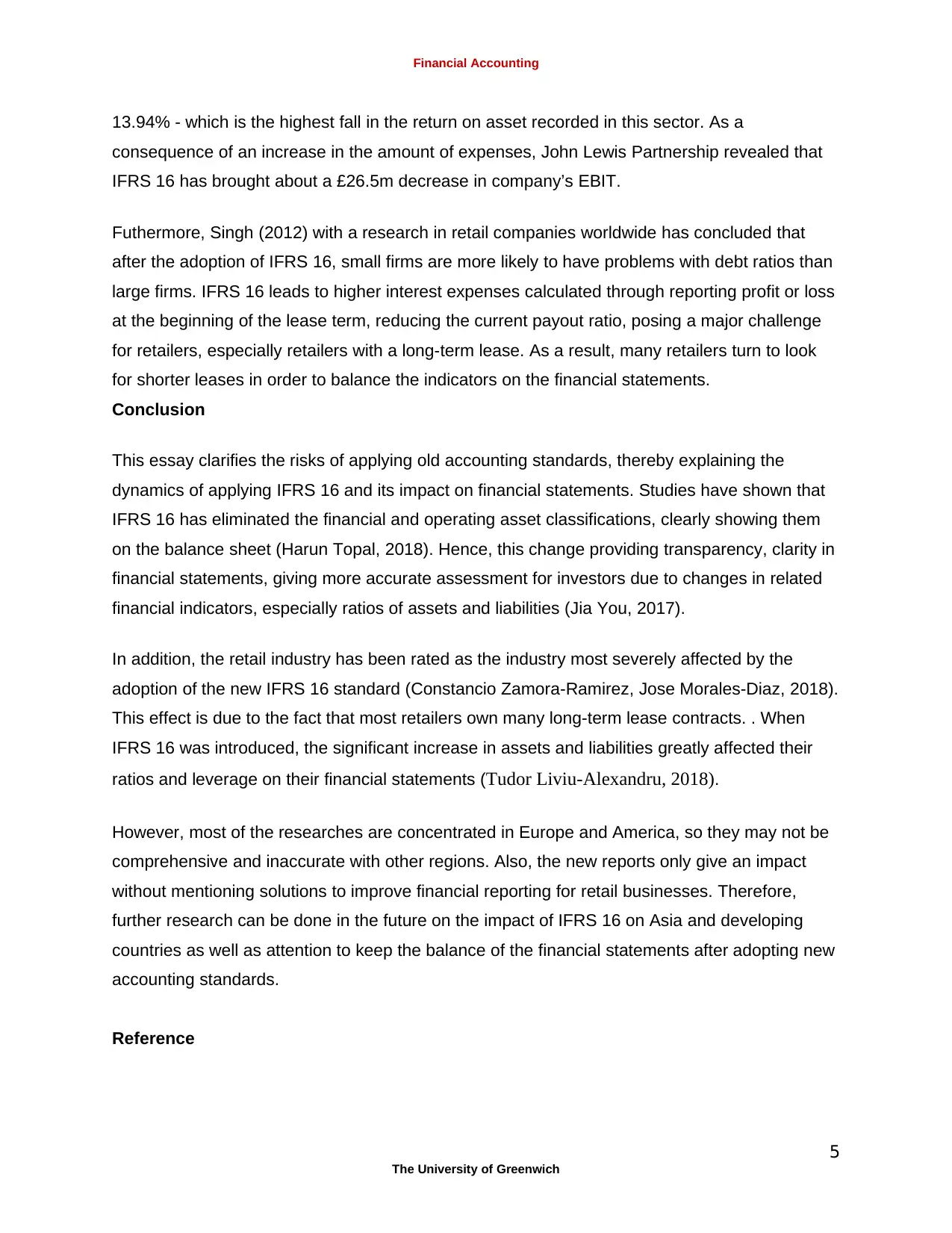
Financial Accounting
13.94% - which is the highest fall in the return on asset recorded in this sector. As a
consequence of an increase in the amount of expenses, John Lewis Partnership revealed that
IFRS 16 has brought about a £26.5m decrease in company’s EBIT.
Futhermore, Singh (2012) with a research in retail companies worldwide has concluded that
after the adoption of IFRS 16, small firms are more likely to have problems with debt ratios than
large firms. IFRS 16 leads to higher interest expenses calculated through reporting profit or loss
at the beginning of the lease term, reducing the current payout ratio, posing a major challenge
for retailers, especially retailers with a long-term lease. As a result, many retailers turn to look
for shorter leases in order to balance the indicators on the financial statements.
Conclusion
This essay clarifies the risks of applying old accounting standards, thereby explaining the
dynamics of applying IFRS 16 and its impact on financial statements. Studies have shown that
IFRS 16 has eliminated the financial and operating asset classifications, clearly showing them
on the balance sheet (Harun Topal, 2018). Hence, this change providing transparency, clarity in
financial statements, giving more accurate assessment for investors due to changes in related
financial indicators, especially ratios of assets and liabilities (Jia You, 2017).
In addition, the retail industry has been rated as the industry most severely affected by the
adoption of the new IFRS 16 standard (Constancio Zamora-Ramirez, Jose Morales-Diaz, 2018).
This effect is due to the fact that most retailers own many long-term lease contracts. . When
IFRS 16 was introduced, the significant increase in assets and liabilities greatly affected their
ratios and leverage on their financial statements (Tudor Liviu-Alexandru, 2018).
However, most of the researches are concentrated in Europe and America, so they may not be
comprehensive and inaccurate with other regions. Also, the new reports only give an impact
without mentioning solutions to improve financial reporting for retail businesses. Therefore,
further research can be done in the future on the impact of IFRS 16 on Asia and developing
countries as well as attention to keep the balance of the financial statements after adopting new
accounting standards.
Reference
5
The University of Greenwich
13.94% - which is the highest fall in the return on asset recorded in this sector. As a
consequence of an increase in the amount of expenses, John Lewis Partnership revealed that
IFRS 16 has brought about a £26.5m decrease in company’s EBIT.
Futhermore, Singh (2012) with a research in retail companies worldwide has concluded that
after the adoption of IFRS 16, small firms are more likely to have problems with debt ratios than
large firms. IFRS 16 leads to higher interest expenses calculated through reporting profit or loss
at the beginning of the lease term, reducing the current payout ratio, posing a major challenge
for retailers, especially retailers with a long-term lease. As a result, many retailers turn to look
for shorter leases in order to balance the indicators on the financial statements.
Conclusion
This essay clarifies the risks of applying old accounting standards, thereby explaining the
dynamics of applying IFRS 16 and its impact on financial statements. Studies have shown that
IFRS 16 has eliminated the financial and operating asset classifications, clearly showing them
on the balance sheet (Harun Topal, 2018). Hence, this change providing transparency, clarity in
financial statements, giving more accurate assessment for investors due to changes in related
financial indicators, especially ratios of assets and liabilities (Jia You, 2017).
In addition, the retail industry has been rated as the industry most severely affected by the
adoption of the new IFRS 16 standard (Constancio Zamora-Ramirez, Jose Morales-Diaz, 2018).
This effect is due to the fact that most retailers own many long-term lease contracts. . When
IFRS 16 was introduced, the significant increase in assets and liabilities greatly affected their
ratios and leverage on their financial statements (Tudor Liviu-Alexandru, 2018).
However, most of the researches are concentrated in Europe and America, so they may not be
comprehensive and inaccurate with other regions. Also, the new reports only give an impact
without mentioning solutions to improve financial reporting for retail businesses. Therefore,
further research can be done in the future on the impact of IFRS 16 on Asia and developing
countries as well as attention to keep the balance of the financial statements after adopting new
accounting standards.
Reference
5
The University of Greenwich
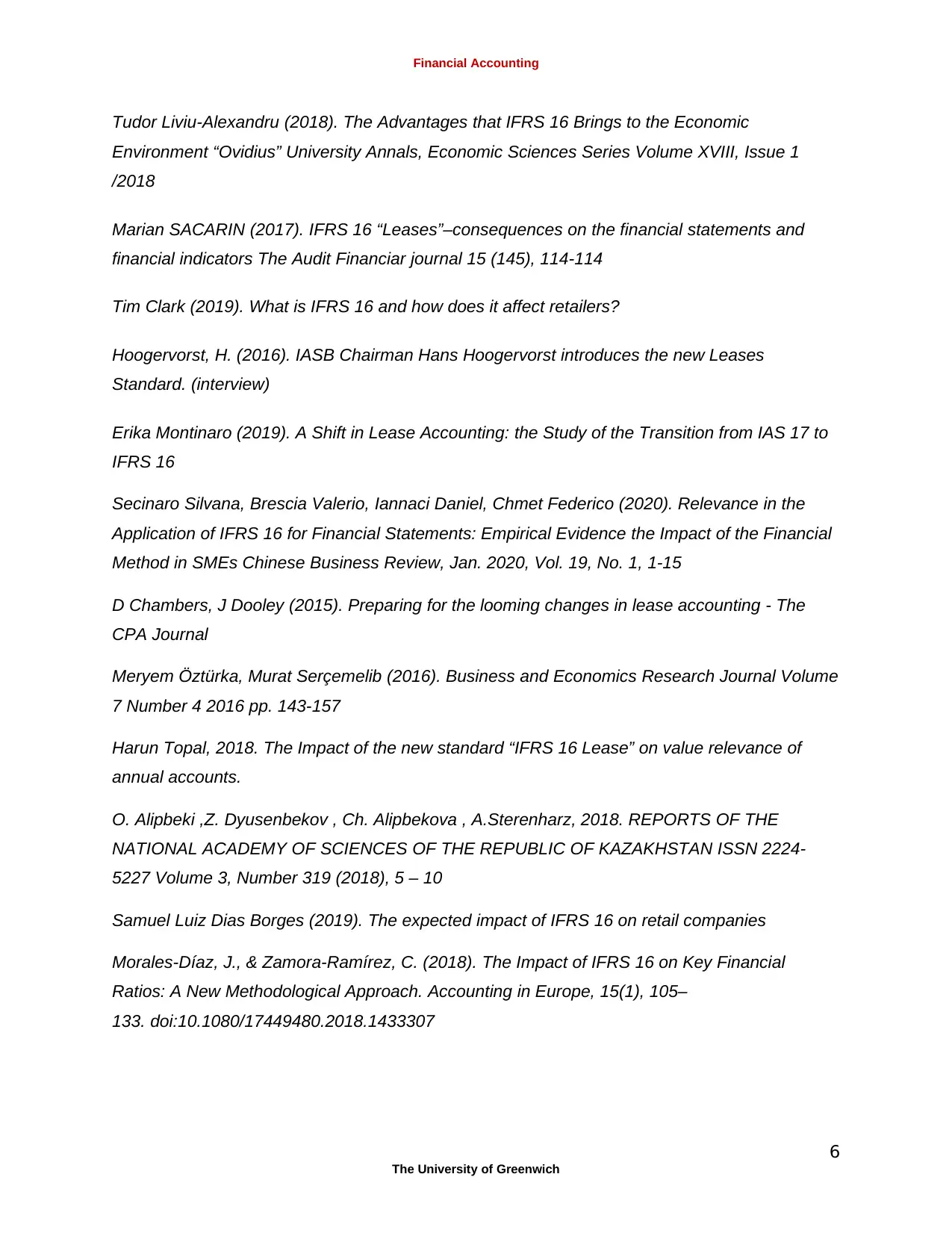
Financial Accounting
Tudor Liviu-Alexandru (2018). The Advantages that IFRS 16 Brings to the Economic
Environment “Ovidius” University Annals, Economic Sciences Series Volume XVIII, Issue 1
/2018
Marian SACARIN (2017). IFRS 16 “Leases”–consequences on the financial statements and
financial indicators The Audit Financiar journal 15 (145), 114-114
Tim Clark (2019). What is IFRS 16 and how does it affect retailers?
Hoogervorst, H. (2016). IASB Chairman Hans Hoogervorst introduces the new Leases
Standard. (interview)
Erika Montinaro (2019). A Shift in Lease Accounting: the Study of the Transition from IAS 17 to
IFRS 16
Secinaro Silvana, Brescia Valerio, Iannaci Daniel, Chmet Federico (2020). Relevance in the
Application of IFRS 16 for Financial Statements: Empirical Evidence the Impact of the Financial
Method in SMEs Chinese Business Review, Jan. 2020, Vol. 19, No. 1, 1-15
D Chambers, J Dooley (2015). Preparing for the looming changes in lease accounting - The
CPA Journal
Meryem Öztürka, Murat Serçemelib (2016). Business and Economics Research Journal Volume
7 Number 4 2016 pp. 143-157
Harun Topal, 2018. The Impact of the new standard “IFRS 16 Lease” on value relevance of
annual accounts.
O. Alipbeki ,Z. Dyusenbekov , Ch. Alipbekova , A.Sterenharz, 2018. REPORTS OF THE
NATIONAL ACADEMY OF SCIENCES OF THE REPUBLIC OF KAZAKHSTAN ISSN 2224-
5227 Volume 3, Number 319 (2018), 5 – 10
Samuel Luiz Dias Borges (2019). The expected impact of IFRS 16 on retail companies
Morales-Díaz, J., & Zamora-Ramírez, C. (2018). The Impact of IFRS 16 on Key Financial
Ratios: A New Methodological Approach. Accounting in Europe, 15(1), 105–
133. doi:10.1080/17449480.2018.1433307
6
The University of Greenwich
Tudor Liviu-Alexandru (2018). The Advantages that IFRS 16 Brings to the Economic
Environment “Ovidius” University Annals, Economic Sciences Series Volume XVIII, Issue 1
/2018
Marian SACARIN (2017). IFRS 16 “Leases”–consequences on the financial statements and
financial indicators The Audit Financiar journal 15 (145), 114-114
Tim Clark (2019). What is IFRS 16 and how does it affect retailers?
Hoogervorst, H. (2016). IASB Chairman Hans Hoogervorst introduces the new Leases
Standard. (interview)
Erika Montinaro (2019). A Shift in Lease Accounting: the Study of the Transition from IAS 17 to
IFRS 16
Secinaro Silvana, Brescia Valerio, Iannaci Daniel, Chmet Federico (2020). Relevance in the
Application of IFRS 16 for Financial Statements: Empirical Evidence the Impact of the Financial
Method in SMEs Chinese Business Review, Jan. 2020, Vol. 19, No. 1, 1-15
D Chambers, J Dooley (2015). Preparing for the looming changes in lease accounting - The
CPA Journal
Meryem Öztürka, Murat Serçemelib (2016). Business and Economics Research Journal Volume
7 Number 4 2016 pp. 143-157
Harun Topal, 2018. The Impact of the new standard “IFRS 16 Lease” on value relevance of
annual accounts.
O. Alipbeki ,Z. Dyusenbekov , Ch. Alipbekova , A.Sterenharz, 2018. REPORTS OF THE
NATIONAL ACADEMY OF SCIENCES OF THE REPUBLIC OF KAZAKHSTAN ISSN 2224-
5227 Volume 3, Number 319 (2018), 5 – 10
Samuel Luiz Dias Borges (2019). The expected impact of IFRS 16 on retail companies
Morales-Díaz, J., & Zamora-Ramírez, C. (2018). The Impact of IFRS 16 on Key Financial
Ratios: A New Methodological Approach. Accounting in Europe, 15(1), 105–
133. doi:10.1080/17449480.2018.1433307
6
The University of Greenwich
⊘ This is a preview!⊘
Do you want full access?
Subscribe today to unlock all pages.

Trusted by 1+ million students worldwide
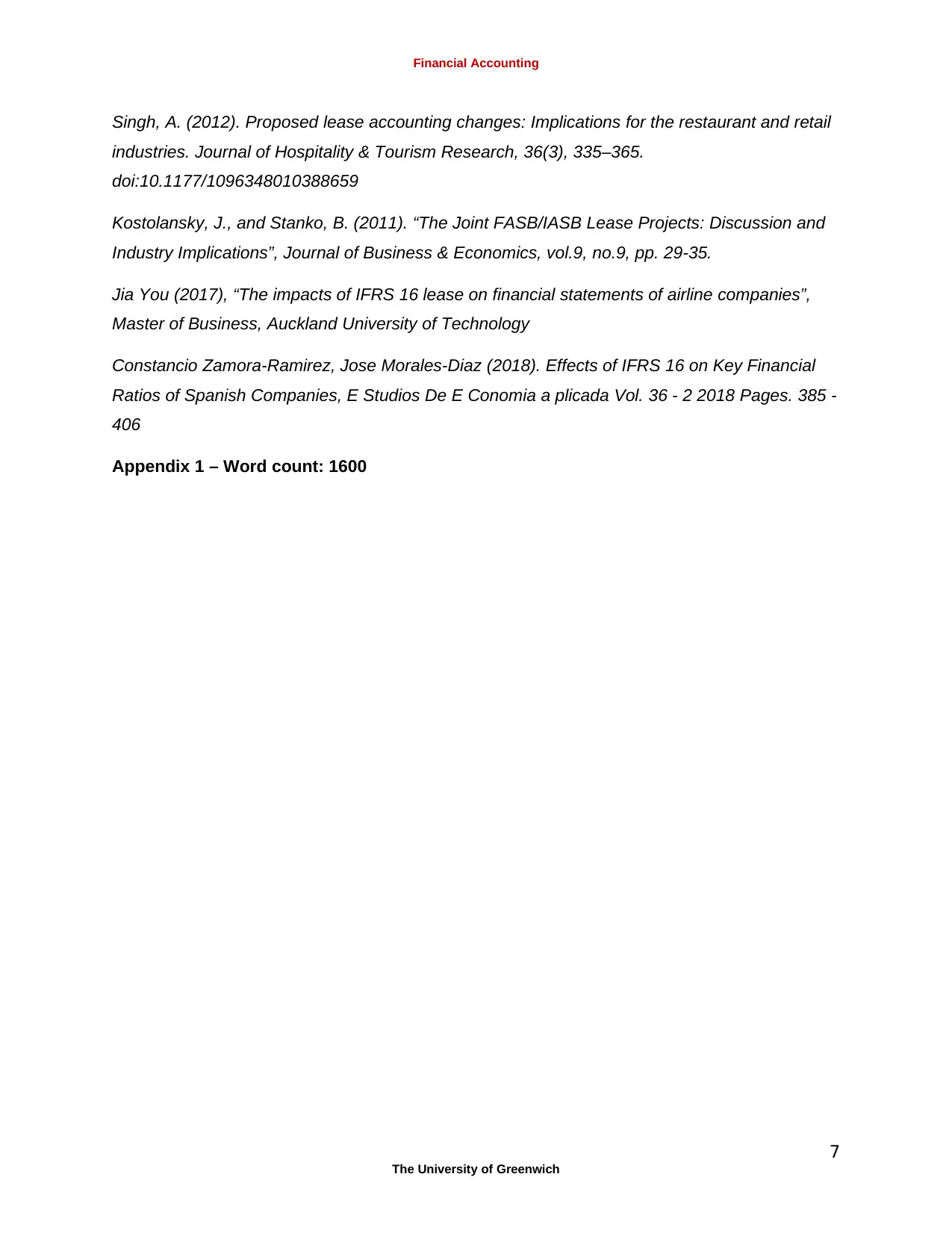
Financial Accounting
Singh, A. (2012). Proposed lease accounting changes: Implications for the restaurant and retail
industries. Journal of Hospitality & Tourism Research, 36(3), 335–365.
doi:10.1177/1096348010388659
Kostolansky, J., and Stanko, B. (2011). “The Joint FASB/IASB Lease Projects: Discussion and
Industry Implications”, Journal of Business & Economics, vol.9, no.9, pp. 29-35.
Jia You (2017), “The impacts of IFRS 16 lease on financial statements of airline companies”,
Master of Business, Auckland University of Technology
Constancio Zamora-Ramirez, Jose Morales-Diaz (2018). Effects of IFRS 16 on Key Financial
Ratios of Spanish Companies, E Studios De E Conomia a plicada Vol. 36 - 2 2018 Pages. 385 -
406
Appendix 1 – Word count: 1600
7
The University of Greenwich
Singh, A. (2012). Proposed lease accounting changes: Implications for the restaurant and retail
industries. Journal of Hospitality & Tourism Research, 36(3), 335–365.
doi:10.1177/1096348010388659
Kostolansky, J., and Stanko, B. (2011). “The Joint FASB/IASB Lease Projects: Discussion and
Industry Implications”, Journal of Business & Economics, vol.9, no.9, pp. 29-35.
Jia You (2017), “The impacts of IFRS 16 lease on financial statements of airline companies”,
Master of Business, Auckland University of Technology
Constancio Zamora-Ramirez, Jose Morales-Diaz (2018). Effects of IFRS 16 on Key Financial
Ratios of Spanish Companies, E Studios De E Conomia a plicada Vol. 36 - 2 2018 Pages. 385 -
406
Appendix 1 – Word count: 1600
7
The University of Greenwich
1 out of 7
Related Documents
Your All-in-One AI-Powered Toolkit for Academic Success.
+13062052269
info@desklib.com
Available 24*7 on WhatsApp / Email
![[object Object]](/_next/static/media/star-bottom.7253800d.svg)
Unlock your academic potential
Copyright © 2020–2025 A2Z Services. All Rights Reserved. Developed and managed by ZUCOL.



